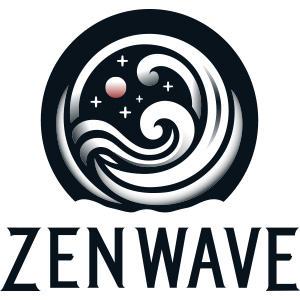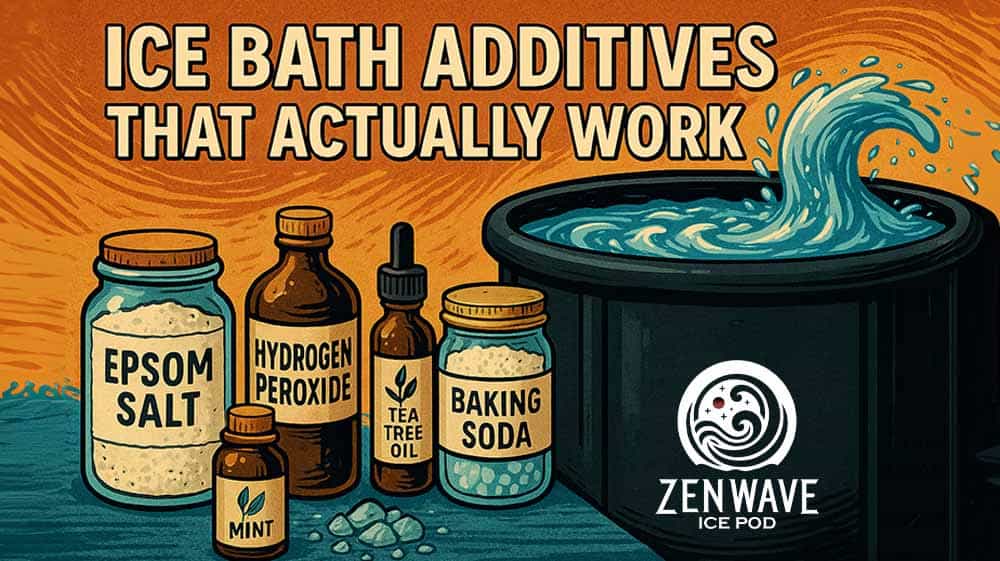Once you’ve dialed in your cold plunge basics — temperature, duration, and routine — the next frontier is what goes into the water itself. Ice bath additives can make a massive difference in water cleanliness, sensory experience, and even recovery outcomes.
From Epsom salts that enhance magnesium absorption to hydrogen peroxide that keeps water crystal clear, the right additives can upgrade your plunge while protecting your equipment. But not all substances are safe — and some can damage chillers, corrode metal, or irritate skin if used incorrectly.
In this guide, we rank the most effective and widely used ice bath additives based on performance, safety, and use case — and show you exactly how to dose and combine them for recovery, water quality, or mental edge.
Why Add Anything to an Ice Bath?
The cold itself does a lot. But these additives?
They either:
- Support recovery with transdermal electrolytes
- Extend water life and keep it crystal clear
- Make the plunge feel colder — or more bearable
Think of them like performance upgrades. You don’t need them to get results — but the right stack can make a noticeable difference.
The Core Additives — Ranked by Impact
1. Epsom Salt (Magnesium Sulfate)
This is the gold standard. Magnesium plays a direct role in muscle recovery and cold-induced thermogenesis. Plus, Epsom softens the ice so it doesn’t feel like shards on your skin.
- Recommended dose: 4 lbs per 80-gallon tub
- Bonus effect: At 8–10 lbs, water turns into slushy perfection
- Thermodynamic edge: Lowers freezing point; slush can dip below 32°F
- Watch for: Algae growth in stainless steel tubs without zinc or strong filtration
- Safety: Generally very safe. No known risks when used at recommended doses.
Want the deep science on this? We unpack it in our full guide on the benefits of Epsom salt in ice baths.
2. Food-Grade Hydrogen Peroxide (3%)
Hydrogen peroxide (H2O2) is a powerful yet simple water sanitizer that’s earned its place in nearly every cold plunge protocol. It oxidizes organic debris, eliminates bacteria, and helps maintain crystal-clear water without irritating skin or producing chemical by-products.
- Recommended dose: 2 oz per 10 gallons every 2–3 days (or about 32 oz for a 100-gallon tub)
- Best practice: Add after your plunge to keep the disinfectant active
- Advantages: Odorless, skin-safe, non-toxic, and environmentally friendly — it breaks down into water and oxygen
- Maintenance tip: If water looks cloudy or starts to smell, add a half-dose between full water changes
- Safety: Safe when diluted properly. Can cause irritation if over-concentrated.
Stick to 3% household peroxide (like Simple Nature) for safety and ease. Higher concentrations (12% or more) are harder to dose and can irritate skin.
For more details and a full dosage chart by tub size, check out our guide to using hydrogen peroxide for ice baths — and don’t miss our tips on how often to change your ice bath water to prevent buildup.
3. Zinc Sulfate
This one is underrated. It’s a strong algae suppressor — and zinc supports immune function when absorbed through the skin. It also helps prevent biofilm from forming in hard-to-clean filtration components, especially in tubs with limited ozone circulation.
- Recommended dose: 1 tablespoon every 2 weeks
- Results: Ultra-clear water, less filter gunk, longer filter lifespan
- Extra: Zinc is a known coagulant, helping small particles clump for easier filtration
- Warning: Don’t drink the plunge water
- Safety: Safe under 5 ppm. Overuse can cause nausea or mild skin irritation.
Want more insight into keeping your ice bath clean and safe? This additive plays a key role.
4. Potassium Sulfate
Cold exposure burns through potassium — which helps regulate muscle function and energy metabolism. A little potassium sulfate goes a long way. It also slightly increases water conductivity, which can improve chiller efficiency in some setups.
- Recommended dose: 1 lb every few weeks
- Effect: Fewer calf cramps, slightly colder water, possible chiller support
- Science: Transdermal potassium may help maintain electrolyte balance during repeated cold exposure
- Safety: Generally considered safe in the small quantities used for cold plunges.
5. Tea Tree Oil (with Emulsifier)
Smells clean. Kills microbes. Feels like a spa. But only works if emulsified first. Tea tree also has mild anti-inflammatory properties, which may complement post-plunge recovery routines.
- Recommended mix: 10 drops tea tree + 1 tbsp MCT oil
- Without emulsifier: You’ll get an oily slick on top of the tub
- Additional tip: Add after filtration cycle to preserve potency
- Safety: Always use a carrier oil. Undiluted oils can cause skin irritation and leave surface film.
6. Baking Soda
Simple, cheap, and effective. It helps balance water pH and softens the feel of the plunge. Baking soda also acts as a mild deodorizer, making it a solid option if multiple people are using the same tub.
- Recommended dose: 1/4 cup per 80 gallons
- Combo tip: Works well with peroxide to extend water life
- Bonus: May reduce chlorine or acidic contaminants in municipal water
- Safety: Low-risk and skin-safe when used in moderation.
7. Menthol Crystals / Peppermint Oil
This is the trick when you want the plunge to feel 5 degrees colder — even if the temp hasn’t changed. Menthol activates the TRPM8 receptors in your skin, which signal “cold” to your brain regardless of actual temperature.
- Recommended dose: 0.5 g menthol crystals pre-dissolved in hot water
- Caution: Start small — menthol can sting if overdone
- Pro Tip: Use pre/post workout for enhanced mental reset
- Safety: Always pre-dissolve crystals. Direct contact can burn.
8. Copper Sulfate (Trace Dose)
Massive antimicrobial power — but only for stainless steel tubs. Never use this in a galvanized setup. Copper ions can react with the zinc coating in galvanized steel, causing corrosion and depositing black copper residue in the tub. This weakens the protective coating, shortens the lifespan of the tub, and introduces unwanted metal interactions.
- Recommended dose: A few grains (measured to stay under 2 ppm)
- Effect: Stops biofilm buildup, keeps water insanely clean
- Warning: Copper overdose can cause nausea or toxicity; test frequently
- Important: Skip copper if you’re also taking copper supplements
- Safety: Toxic above 2 ppm. Always use test strips every 2–3 weeks.
Use test strips to keep copper within a safe range.
Additive Safety: What to Avoid & Watch For
Using the wrong additive — or the right one in the wrong way — can wreck your setup or irritate your skin. Here’s what to know:
What Additives Should You Avoid?
Certain common substances can do more harm than good. Avoid anything not designed or explicitly tested for cold plunge use. These include:
- Household cleaners
- Vinegar (disrupts pH and can corrode metal parts)
- Essential oils without an emulsifier
- Hydrogen peroxide stronger than 3%
Learn what else to watch out for in our dedicated guide on what additives to avoid in ice baths.
Can Salt Damage Your Ice Bath Tub?
Yes — especially if your tub is made of galvanized steel or has low-grade internal components. Even common salts like Epsom and potassium sulfate can corrode metal if the setup isn’t compatible. Stainless steel generally holds up, but always check your materials.
We go deeper into the risks (and prevention) in can salt damage your ice bath tub?.
Are Additives Safe for Water Chillers?
Some are, some aren’t. Hydrogen peroxide and baking soda are usually safe. But others — like zinc, copper, and high doses of salt — can cause buildup, reduce lifespan, or even void your warranty if the chiller isn’t built for them.
Want to protect your system? Read our full breakdown in are ice bath additives safe for water chillers?.
Quick Comparison Table
| Additive | Benefit | Safe for Tub | Sensory Impact | Dose |
|---|---|---|---|---|
| Epsom Salt | Recovery, ice softening | ✅ All | Slushy, soft water | 4 lb / 80 gal |
| Hydrogen Peroxide | Water clarity, odor control | ✅ All | None | 2 oz / 10 gal |
| Zinc Sulfate | Algae control, immunity boost | ✅ All | Neutral | 1 tbsp / 80 gal |
| Potassium Sulfate | Electrolyte support | ✅ All | Neutral | 1 lb / 80 gal |
| Tea Tree Oil | Antimicrobial, scent | ✅ With emulsifier | Spa-like scent | 10 drops |
| Baking Soda | pH balance | ✅ All | Smooth water | 1/4 cup / 80 gal |
| Menthol Crystals | Increased cold perception | ✅ All | Tingle, cooling | 0.5 g |
| Copper Sulfate | Antimicrobial | ❌ Galvanized | None | Trace (<2 ppm) |
Advanced Additive Stacks
💪 Recovery Stack
- Includes: Epsom Salt + Potassium Sulfate + Baking Soda
- Optional: Add Menthol post-training for a sharper wake-up
🧼 Water Clarity Stack
- Includes: Zinc Sulfate + Hydrogen Peroxide + Trace Copper
- Note: Use only in stainless steel tubs — never galvanized
🧠 Mental Toughness Stack
- Includes: Menthol + Epsom Salt (Slushy) + Low Temp (33°F)
- Effect: Pushes cold perception and builds resilience
🧬 Immune Support Stack
- Includes: Zinc Sulfate + Hydrogen Peroxide + Tea Tree Oil
- Effect: Combines microbial control with skin-level immune support
Cycling Protocol (Keep It Clean, Keep It Effective)
Every Week:
- Re-dose peroxide + baking soda
- Add Epsom salt with every water top-off
Every 2 Weeks:
- Add zinc sulfate
- Test water pH and clarity
Monthly:
- Consider copper micro-dose (stainless only)
- Drain/refresh if water clarity or smell fades
Best Additives by Goal
| Goal | Additives |
| Muscle Recovery | Epsom + Potassium + Baking Soda |
| Water Clarity | Zinc + Peroxide + Copper |
| Mental Toughness | Menthol + Epsom Slush |
| Immune Boost | Zinc + Peroxide + Tea Tree |
| pH & Skin Balance | Baking Soda + Tea Tree |
Final Thoughts
Cold water is the foundation. Additives are the enhancements.
Whether you’re optimizing for recovery, water longevity, mental toughness, or immune support, a smart additive strategy can elevate your plunge from basic to elite.
But use caution: Start small, observe how your body and water react, and never combine substances blindly. Track what you add. Adjust your doses. And when in doubt, reset.
For tubs like the ZenWave Ice Pod — which are built to handle salt, peroxide, and more — these additives become tools, not risks. When used properly, they make the cold cleaner, safer, and more rewarding.
Stay cold. Stay sharp.
Read Next:

